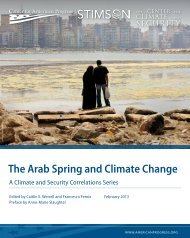Coal Kills
1TndvUf
1TndvUf
You also want an ePaper? Increase the reach of your titles
YUMPU automatically turns print PDFs into web optimized ePapers that Google loves.
What are the anticipated changes in the contribution of coal-fired TPPs to ambient pollution?<br />
Following the methodologies utilised in the previous assessments, the emissions from the future<br />
coal-fired TPPs through 2030 are also assessed for their impacts on the human health, due to the<br />
outdoor air pollution from the primary and secondary PM 2.5 pollution.<br />
Figure 9: Pollution and health impact assessment schematics employed in this study<br />
The atmospheric dispersion modeling of the emissions from all the coal-fired TPPs was<br />
conducted, following the above schematic and using the ENVIRON - Comprehensive Air Quality<br />
Model with Extensions (CAMx), an Eulerian photochemical dispersion model, suitable for<br />
integrated assessments of gaseous and particulate air pollution. The model formulation,<br />
advection and scavenging schematics, chemical solvers, and gas-to-aerosol conversion<br />
mechanisms 17 .<br />
The most important advantage of CAMx is the use of 3D meteorology and independently control<br />
plume rise and emission release point for each power plant, according to the stability profile at<br />
the plants location. The meteorological data (3D wind, temperature, pressure, relative humidity,<br />
and precipitation fields) is derived from the National Center for Environmental Prediction 18 , a<br />
global reanalysis database and processed through WRF 3.5.1 meteorological model at 1 hour<br />
temporal resolution 19 . The horizontal resolution of the analysis is 0.25° grid (approximately 25km<br />
x 25km grids). The vertical resolution of the model extends to 10.5km stretched over 28 layers,<br />
with the lowest layer designated at 30m and 15 layers within 1km to advance vertical advection<br />
closer to the ground level.<br />
17 The model utilises full gas phase chemistry with 217 reactions and 114 species; with two mode coarse/fine PM fractions including gas<br />
to aerosol conversions, for SO2 to sulphates, NOx to nitrates, and VOCs to secondary organic aerosols (SOA). The removal processes<br />
include dry deposition schemes using an updated approach with 26 landuse patterns and wet deposition due to predominant<br />
meteorological conditions. More details on the model architecture, manual, and operational instructions are available @<br />
http://www.camx.com.<br />
18 NCEP operational meteorological fields are available @ http://rda.ucar.edu/datasets/ds083.2/index.html<br />
19 The Weather Research and Forecasting (WRF) model is a state-of-the-art meteorological modeling system to generate CAMx<br />
dispersion model ready data for chemical transport modeling at multiple scales. More details on the model architecture, manual, and<br />
operational instructions are available @ http://wrf-model.org/index.php<br />
17 | <strong>Coal</strong>-fired TPPs in India




